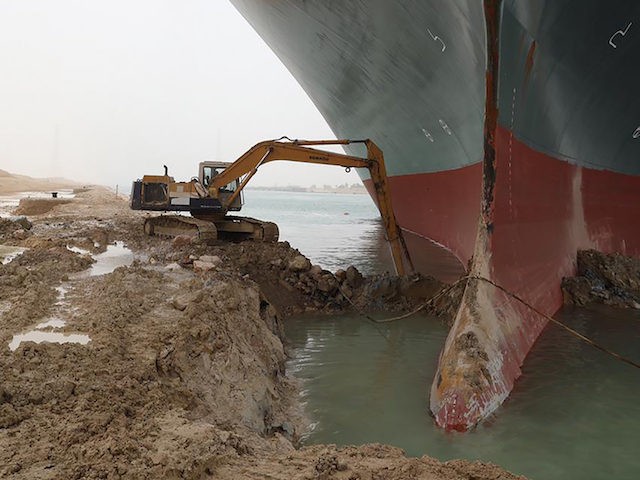The closure of the Suez Canal, one of the world’s busiest maritime shipping lanes, continues into its second day after a cargo ship ran aground and completely blocked passage between the Red and Mediterranean Seas.
The Suez Canal Authority announced Thursday it was “temporarily suspending navigation” through the canal as maritime traffic backed up on both ends, Agence France-Presse reported.
On Wednesday, the MV Ever Given, one of the largest operating cargo vessels, ran aground and turned to lodge its bow and stern at opposing ends of the canal, resulting in the first total blockage of the route in history. The ship sails under a Panamanian flag, though Japanese firm Shoei Kisan owns it with the Taiwanese Evergreen Marine Corp responsible for its operation.
Evergreen attributed the debacle to unusually high winds and a sandstorm present in the area at the time of the vessel’s entry into the canal. Egyptian officials confirmed the weather patterns but have yet to formally produce an explanation for the vessel’s course deviation. Early reports suggested the vessel was experiencing power failures before the incident. Bernhard Schulte Shipmanagement, the firm directly managing the Ever Given, explicitly denied this, saying “Initial investigations rule out any mechanical or engine failure as a cause of the grounding.” The company further noted that there were no injuries and all of the ship’s cargo had been saved.
Initially, the Suez Canal Authority was optimistic in its timetable for clearing the blockage, estimating traffic might fully resume within two days. Early efforts at moving the Ever Given may have fueled that sentiment, with tugboats able to move the boat to one side of the canal by late Wednesday morning. Thursday’s statement from the Authority, however, stands in stark contrast to the positive tone it set in the fiasco’s infancy.
As of Thursday morning, the tugboats had resumed their efforts, delayed by nightfall, to dig out and re-float the 220,000-ton cargo ship, the Wall Street Journal reported. On-the-ground experts offered pessimistic estimates on the timetable. Dutch salvage expert Peter Berdowski, whom Evergreen hired to help move the ship, vaguely estimated the operation would last “days to weeks.”
Egypt, under President Abdel Fattah el-Sissi, has ramped up efforts to expand the canal to allow for two-way traffic of larger vessels, though even such projects have not widened the passage enough to accommodate the Ever Given’s 1300-ft total length.
As of Wednesday, more than 70 ships were waiting on either side of the canal, prompting concerns that such a large concentration of stationary cargo presented a tempting target for Iran, a known maritime predator.
The backlog of shipping is already generating economic fallout. On Wednesday, crude oil prices rose by nearly 3 percent as Middle Eastern fuel shipments to Europe became imperiled.
The Suez Canal sees over ten percent of worldwide shipping pass through its waters each year. Without the critical passage linking the Red and Mediterranean Seas, maritime trading vessels have no alternative route but to sail around the Cape of Good Hope in South Africa and circle the entire continent, a vastly longer route incurring additional expenses and holding little appeal for anyone other than 15th-Century Portuguese spice traders.
Completion of the canal under British rule in 1869 allowed trade to bypass the longer route and made the region a crucial economic center for the Empire. Even after Egyptian independence, British and French entities retained control of the vital waterway after Egyptian leader Gamal Abdel Nasser nationalized the Suez Canal Company in 1956, prompting a military intervention that failed to reclaim control of the waterway.

COMMENTS
Please let us know if you're having issues with commenting.